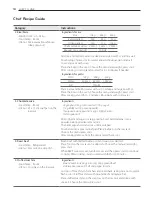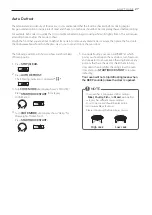
30
FOOD CHARACTERISTICS & MICROWAVE COOKING
Browning
Meats and poultry that are cooked fifteen minutes or longer will brown lightly in their own fat. Foods that are
cooked for a shorter period of time may be brushed with a browning sauce such as worcestershire sauce, soy
sauce or barbecue sauce to achieve an appetising colour. Since relatively small amounts of browning sauces are
added to food, the original flavour of the recipe is not altered.
Covering with greaseproof paper
It provides a looser cover than a lid or cling film, which may dry food out slightly. But because it makes a looser
cover than a lid or clingfilm, it allows the food to dry out slightly.
Arranging and spacing
Individual foods such as baked potatoes, small cakes and hors d’oeuvres will heat more evenly if placed in the oven
at an equal distance apart, preferably in a circular pattern. Never stack foods on top of one another.
stirring
Stirring is one of the most important of all microwaving techniques. In conventional cooking, food is stirred for the
purpose of blending. Microwaved food, however, is stirred in order to spread and redistribute heat. Always stir from
the outside towards the centre as the outside of the food heats first.
turning over
Large, tall foods such as roasts and whole chickens should be turned so that the top and bottom will cook evenly.
It is also a good idea to turn cut up chicken and chops.
placing thicker portions facing outwards
Since microwaves are attracted to the outside portion of food, it makes sense to place thicker portions of meat,
poultry and fish to the outer edge of the baking dish. This way, thicker portions will receive the most microwave
energy and the food will cook evenly.
shielding
Strips of aluminium foil (which block microwaves) can be placed over the corners or edges of square and
rectangular foods to prevent those portions from overcooking. Never use too much foil and make sure the foil is
secured to the dish or it may cause‘arcing’ in the oven.
elevating
Thick or dense foods can be elevated so that microwaves can be absorbed by the underside and centre of the
foods.
piercing
Foods enclosed in a shell, skin or membrane are likely to burst in the oven unless they are pierced prior to cooking.
Such foods include yolks and whites of eggs, clams and oysters and whole vegetables and fruits.
testing if cooked
Food cooks so quickly in a oven, it is necessary to test it frequently. Some foods are left in the microwave until
completely cooked, but most foods, including meats and poultry, are removed from the oven while still slightly
undercooked and allowed to finish cooking during standing time. The internal temperature of foods will rise
between 5° F (3° C) and 15° F (8° C) during standing time.
standing time
Foods are often allowed to stand for 3 to 10 minutes after being removed from the oven. Usually the foods are
covered during standing time to retain heat unless they are supposed to be dry in texture (some cakes and
biscuits, for example). Standing allows foods to finish cooking and also helps flavour blend and develop.
Food CHArACterIstICs & MICroWAve CookIng







































